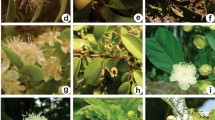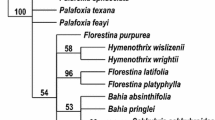Abstract
Evaluation of sequence variations in the internal transcribed spacer (ITS) region of 19 accessions, comprising of 11 accessions of Chenopodium quinoa, eight accessions of Chenopodium album and 165 retrieved sequences of different species of Chenopodium belonging to subfamily Chenopodioideae revealed a higher intraspecific genetic diversity in Himalayan C. album than that in C. quinoa. ITS and amplified fragment-length profiles of the accessions suggest the existence of accessions of Himalayan C. album as heteromorphs of the same species rather than a heterogenous assemblage of taxa. While the evolutionary relationship reconstructed from variations in 184 sequences of ITS region from species belonging to Chenopodiaceae, Amaranthaceae, Polygonaceae and Nelumbonaceae established a paraphyletic evolution of family Chenopodiaceae, it also revealed a monophyletic evolution of Chenopodieae I. The reconstruction also established five independent lineages of the subfamily Chenopodioideae with C. album as a sister clade of C. quinoa within the tribe Chenopodieae I. The results also indicate a much younger age for Himalayan chenopods (C. album) than the reported crown age of Chenopodieae I.




Similar content being viewed by others
References
Alice L. A. and Campbell C. S. 1999 Phylogeny of Rubus (Rosaceae) based on nuclear ribosomal DNA internal transcribed spacer region sequences. Am. J. Bot. 86, 81–97.
Anabalon-Rodiguez L. and Thomet-Isla M. 2009 Comparative analysis of genetic and morphologic diversity among quinoa accessions (Chenopodium quinoa Willd.) of the south of Chile and highland accessions. J. Plant Breed. Crop. Sci. 1, 210–216.
Bhargava A., Shukla S. and Ohri D. 2006 Karyotypic studies on some cultivated and wild species of Chenopodium (Chenopodiaceae). Genet. Resour. Crop Evol. 53, 1309–1320.
Devi R. J. and Chrungoo N. K. 2015 Species relationships in Chenopodiumquinoa and Chenopodiumalbum on the basis of morphology and SDS-PAGE profiles of soluble seed proteins. J. Appl. Biol. Biotech. 3, 29–33.
Downie S., Katz-Downie D. and Cho K. 1997 Relationships in the Caryophyllales as suggested by phylogenetic analyses of partial chloroplast DNA ORF2280 homolog sequences. Am. J. Bot. 84, 253–273.
Fuentes-Bazan S., Mansion G. and Borsch T. 2012a Towards a species level tree of the globally diverse genus Chenopodium (Chenopodiaceae). Mol. Phylogenet. Evol. 62, 359–374.
Fuentes-Bazan S., Uotila P. and Borsch T. 2012b A novel phylogeny-based generic classification for Chenopodium sensulato, and a tribal rearrangement of Chenopodioideae (Chenopodiaceae). Willdenowia 42, 5–24.
Gangopadhyay G., Das S. and Mukerjee K. K. 2002 Speciation in Chenopodium in west Bengal, India. Genet. Resour. Crop Evol. 49, 503–510.
Gutell R. R., Larsen N. and Woese C. R. 1994 Lessons from an evolving ribosomal-RNA – 16S and 23S ribosomal-RNA structures from a comparative perspective. 2Microbiol Rev. 58, 10–26.
Jarvis D. E., Kopp O. R., Jellen E. N., Mallory M. A., Pattee J., Bonifacio A. et al. 2008 Simple sequence repeat marker development and genetic mapping in quinoa (Chenopodium quinoa Willd.). J. Genet. 87, 39–51.
Jarvis D. E., Yung S. H, Damien J. L., Sandra M. S., Bo L., Theo J. A. B. et al. 2017 The genome of Chenopodium quinoa. Nature 542, 307–312.
Joshi B. D. 1991 Genetic resources of leaf and grain Amaranthus and Chenopod. In Biodiversity (ed. M. S. Swam inathan and S. Jana), pp. 121–134. Macmillan India, Chennai.
Kadereit G., Borsch T., Weising K. and Freitag H. 2003 Phylogeny of Amaranthaceae and Chenopodiaceae and the evolution of C4 photosynthesis. Int. J. Plant Sci. 164, 959–986.
Kolano B., Plucienniczak A., Kwasniewski M. and Maluszynska J. 2008 Chromosomal localization of a novel repetitive sequence in the Chenopodium quinoa genome. J. Appl. Genet. 49, 313–320.
Kolano B., McCann J., Orzechowska M., Siwinska D., Temsch E. and Weiss-Schneeweiss H. 2016 Molecular and cytogenetic evidence for an allotetraploid origin of Chenopodium quinoa and C. berlandieri (Amaranthaceae). Mol. Phylogenet. Evol. 100, 109–123.
Kurashige N. S. and Agrawal A. A. 2005 Phenotypic plasticity to light competition and herbivory in Chenopodium album (Chenopodiaceae). Am. J. Bot. 92, 21–26.
La Duke J. and Crawford D. J. 1979 Character compatibility and phyletic relationships in several closely related species of Chenopodium of the Western United States. Taxon 28, 307–314.
Manhart J. R. and Rettig J. H. 1994 Gene sequence data. In Caryophyllales: evolution and systematics (ed. H.-D. Behnke and T. J. Mabry), pp. 235–246. Springer, Berlin.
Mehra P. and Malik C. 1963 Cytology of some Indian Chenopodiaceae. Caryologia 16, 67–84.
Mukherjee K. K. 1986 A comparative study of two cytotypes of Chenopodium album in West Bengal, India. Can. J. Bot. 64, 754–759.
Müller K. 2005 Seqstate: primer design and sequence statistics for phylogenetic DNA datasets. Appl. Bioinform. 4, 65–69.
Müller K. and Borsch T. 2005 Phylogenetics of Amaranthaceae based on matK/trnK sequence data: evidence from parsimony, likelihood, and Bayesian analyses. Ann. Missouri Bot. Gard. 92, 66–102.
Muller T., Philippi N., Dandekar T, Schltz J. and Wolf M. 2007 Distinguishing species. RNA 13, 1469–1472.
Murray M. G. and Thompson W. F. 1980 Rapid isolation of high molecular weight plant DNA. Nucleic Acids Res. 8, 4321–4325.
Palomino G., Hernandez L. T. and Torres E. D. 2008 Nuclear genome size and chromosome analysis in Chenopodium quinoa and C-berlandieri subsp nuttalliae. Euphytica 164, 221–230.
Rahiminejad M. R. and Gornall R. J. 2004 Flavonoid evidence for allopolyploidy in the Chenopodium album aggregate (Amaranthaceae). Plant Syst. Evol. 246, 77–87.
Rana T. S., Narzary D. and Ohri D. 2010 Genetic diversity and relationships among some wild and cultivated species of Chenopodium l. (Amaranthaceae) using RAPD and DAMD methods. Curr. Sci. 98, 840–846.
Rana T. S., Narzary D. and Ohri D. 2011 Molecular differentiation of Chenopodium album complex and some related species using ISSR profiles and ITS sequences. Gene 495, 29–35.
Rohlf F. J. 2000 NTSYS-pc: numerical taxonomy and multivariate analysis system, version 2.10f. Exeter Publishing, New York.
Roldan-Ruiz I., Dendauw J., Bockstaele E. V., Depicker A. and Loose M. D. 2000 AFLP markers reveal high polymorphic rates in rye grasses (Lolium spp.). Mol. Breed. 6, 125–134.
Ruas P. M., Bonifacio A., Ruas C. F., Fairbanks D. J. and Andersen W. R. 1999 Genetic relationships among 19 accessions of six species of Chenopodium l. by random amplified polymorphic DNA fragments (RAPD). Euphytica 105, 25–32.
Schuster T. M., Setaro S. D. and Kron K. A. 2013 Age estimates for the buckwheat family Polygonaceae based on sequence data calibrated by fossils and with a focus on the Amphi-Pacific Muehlenbeckia. PLoS One 8, e61261.
Singh S. 2010 Understanding the weedy Chenopodium complex in the north central states. Dissertation, University of Illinois at Urbana-Champaign.
Tamura K., Peterson D., Peterson N., Stecher G., Nei M. and Kumar S. 2011 MEGA5: molecular evolutionary genetics analysis using maximum likelihood, evolutionary distance, and maximum parsimony methods. Mol. Biol. Evol. 28, 2731–2739.
Vos P., Hogers R., Bleeker R., Reijans M., Van de Lee T., Hornes M. et al. 1995 AFLP: a new technique for DNA fingerprinting. Nucleic Acids Res. 23, 4407–4414.
Walsh B. M., Adhikary D., Maughan P. J., Emshwiller E. and Jellen E. N. 2015 Chenopodium polyploidy inferences from salt overly sensitive 1 (sos1) data. Am. J. Bot. 102, 533–543.
White T. J., Bruns T. D., Lee S. and Taylor J. 1990 Analysis of phylogenetic relationships by amplification and direct sequencing of ribosomal RNA genes. In: PCR protocols: a guide to methods and applications (ed. M. A. Innis, D. H. Gelf and, J. J. Sninsky and T. J. White), pp. 315–322, Academic Press, New York.
Wikström, N., Savolainen V. and Chase M. W. 2001 Evolution of the angiosperms: Calibrating the family tree. Proc. R. Soc. Lond. B, Biol. Sci. 268, 2211–2220.
Wilson H. D. 1980 Artificial hybridization among species of Chenopodium sect. Chenopodium. Sys. Bot. 5, 253–263.
Wilson H. and Manhart J. 1993 Crop/weed gene flow: Chenopodium quinoa Willd. and C. berlandieri moq. Theor. Appl. Genet. 86, 642–648.
Wolf M., Achtziger M., Schultz J., Dandekar T. and Mueller T. 2005 Homology modeling revealed more than 20,000 rRNA internal transcribed spacer 2 (ITS2) secondary structures. RNA 11, 1616–1623.
Acknowledgements
Financial support received from Department of Biotechnology, Govt. of India vide grant no. BT/PR-8953/BCE/08/533/2007 and grant no BT/04/NE/2009 under the Biotech Hub programme is gratefully acknowledged. RJD gratefully acknowledges the receipt of financial support from Department of Science & Technology, Govt. of India in the form of a research fellowship under INSPIRE
Author information
Authors and Affiliations
Corresponding author
Additional information
Corresponding Editor: Manoj Prasad.
Electronic supplementary material
Below is the link to the electronic supplementary material.
Rights and permissions
About this article
Cite this article
Chrungoo, N.K., Jashmi Devi, R., Goel, S. et al. Deciphering species relationships and evolution in Chenopodium through sequence variations in nuclear internal transcribed spacer region and amplified fragment-length polymorphism in nuclear DNA. J Genet 98, 37 (2019). https://doi.org/10.1007/s12041-019-1079-0
Received:
Revised:
Accepted:
Published:
DOI: https://doi.org/10.1007/s12041-019-1079-0




